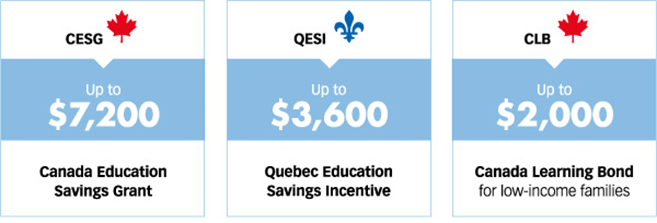
RESP: The #1 Choice of Parents Saving for Post-Secondary Education
📢 Warning: Some of the content on this page may not be current and needs to be updated. If you have any questions about your specific situation, please contact Customer Service or your representative.
With back-to-school season around the corner, parents are starting to make their to-do lists and bracing themselves for the bills to come. And while families with younger children can expect expenses ranging in the hundreds of dollars, many parents with kids in post-secondary education may have to tighten their belts.
The latest edition of the Kaleido1 Education Savings Barometer reveals, not surprisingly, that the vast majority of parents consider their child’s post-secondary education a priority. Ninety-seven percent of them say that education is very important. But education doesn’t come cheap, making it a growing source of concern for 70% of parents surveyed. And with good reason, as they estimate the average cost of post-secondary education at $28,780 for a single child.
It’s no wonder that most families are trying to get a head start. Of the 65% who are saving for post-secondary education, the majority have chosen an RESP, an investment vehicle specifically designed for education savings.
So why is an RESP still the number one choice of parents? Let’s explore what makes this investment so appealing!
1. Free Grant Money Anyone?
The best part of the RESP is the government grants—they’re the main reason parents choose this savings option.2 Makes sense, since the RESP is the only financial product eligible for education savings grants.
So how much are we talking about exactly? First, the federal government offers the Canada Education Savings Grant (CESG), which matches 20% of the first $2,500 contributed each year. The Quebec government provides an additional 10% with the Quebec Education Savings Incentive (QESI). That’s a minimum of 30% in government grants, regardless of family income. No wonder an RESP is everyone’s number one choice!
Low-income families can even get additional CESG and QESI funding, as well as the Canada Learning Bond (CLB), a grant of up to $2,000 per child. In total, government grants provide up to $12,800 per child,3 and always grow tax-free, like your RESP contributions.

While government grants are the main reason parents are so attracted to RESPs, that’s far from the only benefit!

Find out in seconds how much an RESP could earn you with the free calculator.
2. RRSP or RESP... Why Not Both!
While education is often the most important thing for parents, some are also concerned about their retirement. No problem—you can cover both bases by first investing in an RESP!
When an RESP reaches maturity, the contributions are returned to the person who opened the plan—tax-free! Parents can then choose to add this amount to their child’s education fund or invest it in their RRSP.
3. Source of Motivation
RESPs have benefits for students too. Having an RESP in their name is a good motivator for them to continue their education.
Parents aren’t the only ones worried about the cost of post-secondary education; two-thirds of students share this concern. Fortunately, the money in an RESP eases the burden of education costs, allowing students to focus on their studies and accumulate less debt.
This is significant, given that 79% of students work more than 10 hours a week.4
4. Freedom of Choice
With an RESP, parents can enjoy peace of mind knowing their child will have the freedom to study whatever they want. RESPs qualify for educational assistance payments (EAPs) for all levels of post-secondary education, from trade and vocational schools to colleges and universities.5 Young people can study wherever they choose and use EAPs to pay for any education-related expenses, such as tuition, rent, groceries, and school supplies.
In sum, the RESP has a number of benefits for families. It’s a wise investment choice that gives kids the power to dream big without being limited by their financial means!
1, 2, 4. Education Savings Barometer 2019: A web panel survey conducted in collaboration with the CROP polling firm from November 8 to 26, 2018, using a sample of 1,030 Quebec residents.
3. Canada Education Savings Grant (CESG) of 20% to 40% and Quebec Education Savings Incentive (QESI) of 10% to 20%. Based on adjusted family net income. The annual limit is $600 for the CESG and $300 for the QESI. The lifetime limit per beneficiary is $7,200 for the CESG and $3,600 for the QESI. The Canada Learning Bond (CLB) is up to $2,000 per beneficiary, for children born to financially eligible families after December 31, 2003. Some conditions apply; see our prospectus.
5. Provided the program selected is a “qualifying educational program” or a “specified educational program,” as defined in the Income Tax Act (Canada).



